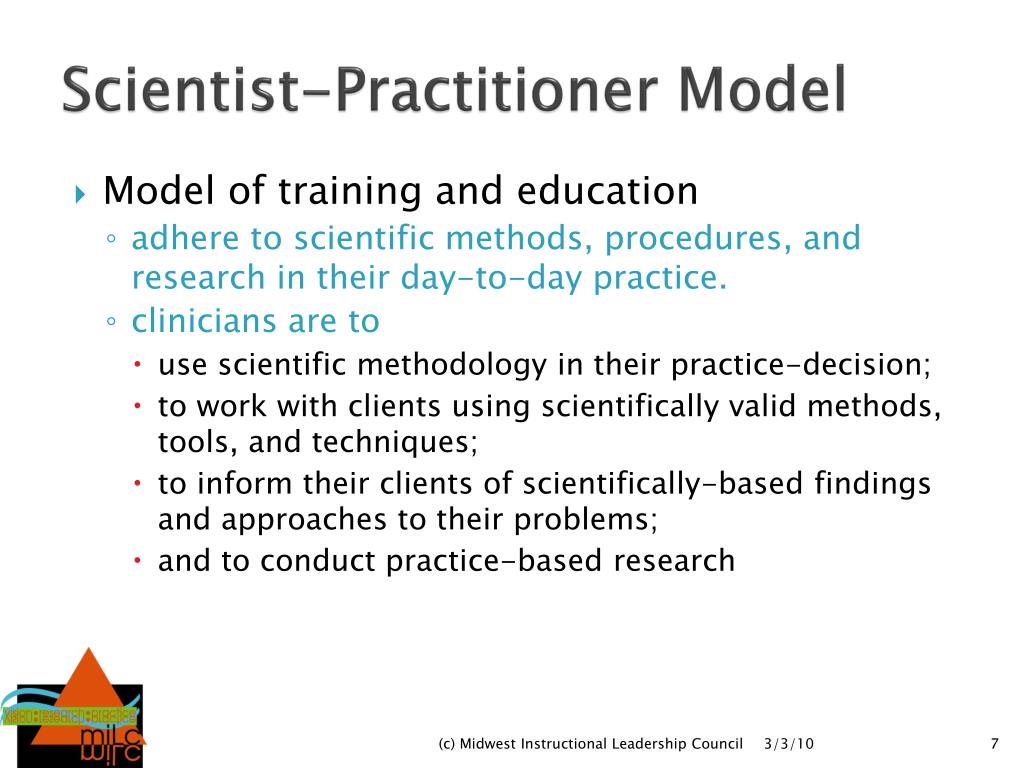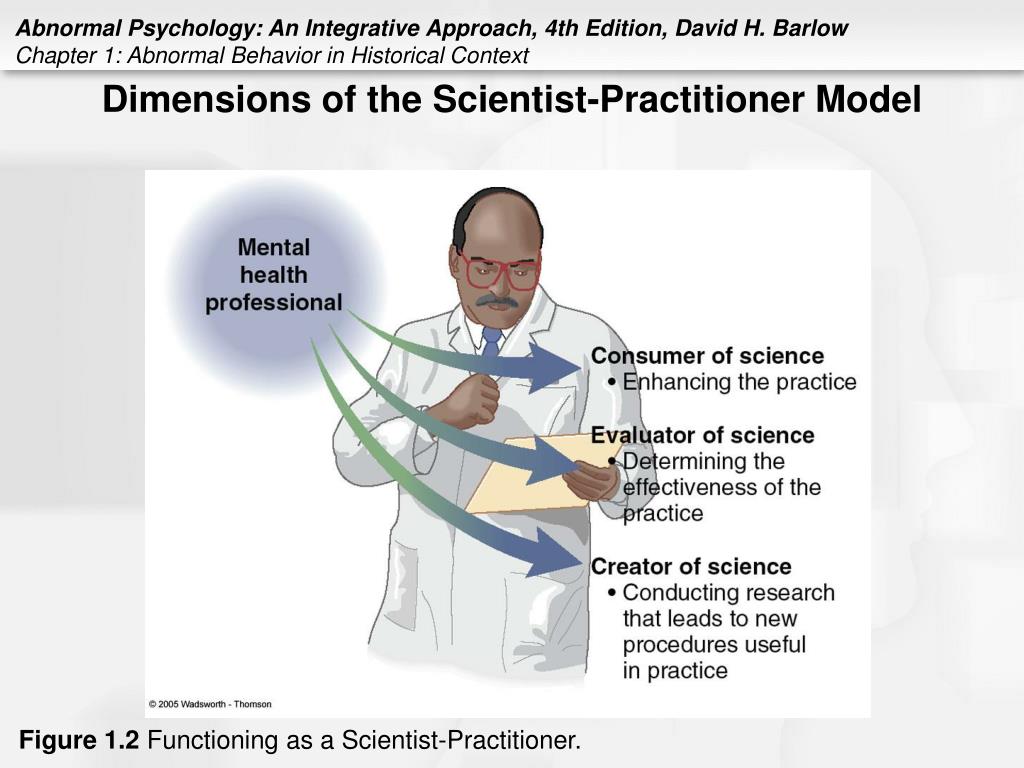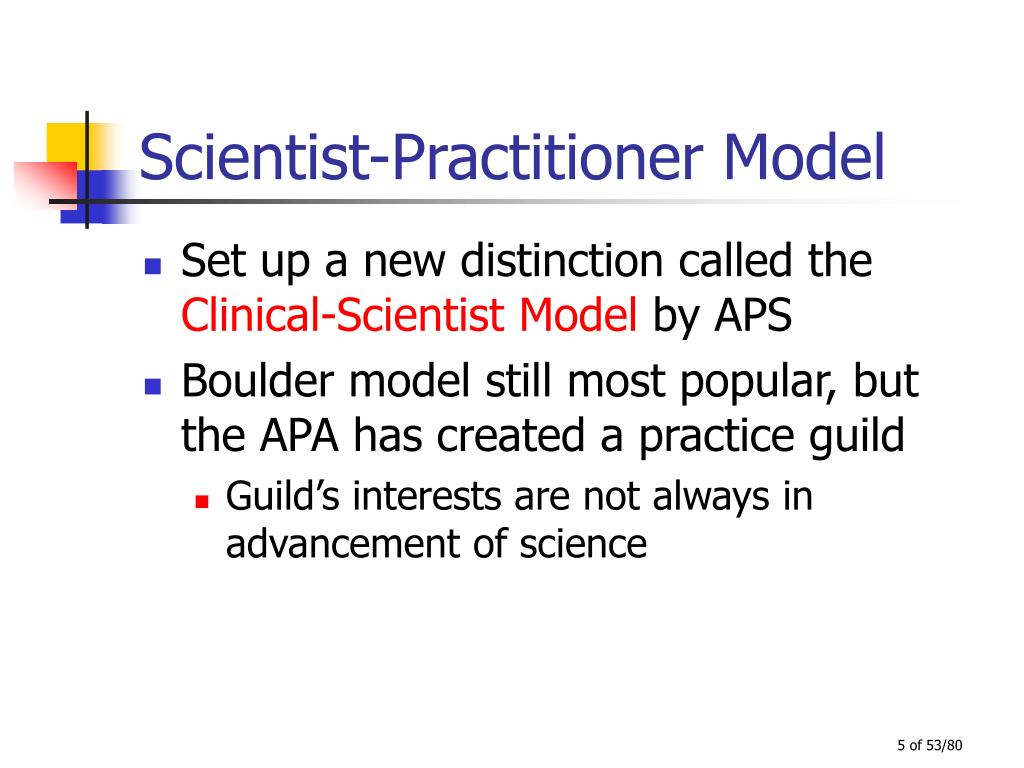
PPT Training Issues in Clinical Psychology PowerPoint Presentation, free download ID4749234
The scientist-practitioner model remains valuable in improving the treatment of individual clients and in enhancing clinical science. One deterrent to its implementation, however, is the unsuitability of traditional research methods to clinical settings.

Thoughts about the ScientistPractitioner model in an organisational context Rebecca Jackson
The scientist-practitioner model (see Shapiro, 2002 ) is a key teaching model for professional psychologists, defining the role of psychologists working in applied settings as applied scientists.

(PDF) The ScientistPractitioner Model in Clinical Psychology A Critique
What is understood as the scientist-practitioner model is disclosed in particular ways of talking and writing, or in a discourse that positions the psychological practitioner as a scientist invested with legitimate epistemic authority. This discourse constitutes the psychological enterprise, and various social arrangements and practices.

PPT Training Issues in Clinical Psychology PowerPoint Presentation, free download ID4749234
This article presents a revised conception of research and practice in counseling psychology that (1) emphasizes the traditional activities of each role that have positive implications for the other role; (2) expands each role to bring each closer to the activities of the other; (3) highlights a number of practices in the humanities and other so.

Scientist Practitioner Model Ppt Powerpoint Presentation Gallery Backgrounds Cpb Presentation
The scientist-practitioner model, also called the Boulder Model, [1] is a training model for graduate programs that provide applied psychologists with a foundation in research and scientific practice. It was initially developed to guide clinical psychology graduate programs accredited by the American Psychological Association (APA).

ScientistPractitioner Model Definition & 10 Examples (2023)
It is argued that the scientific-practitioner model can be differentiating in a highly competitive area of practice, that science can make its research more relevant to practice, and that practitioners have an important role to play in assuring the linkage of practice with research and theory.

PPT Bridging Research and Practice Be the Hyphen! PowerPoint Presentation ID759152
The scientist-practitioner model is the dominant approach to training in clinical psychology, but it is more readily realized in theory than in practice. The articles in this series consider ways to make research more accessible to the practitioner in a realistic and helpful manner, and to allow practitioners to influence the course of research.

PPT Introduction to Psychopathology PowerPoint Presentation ID139476
. This model emphasizes the complementary connection between basic and applied research and professional practice.

Module 2 The ScientistPractitioner Module The ScientistPractitioner Model The scientist
The scientist-practitioner model is the dominant approach to training in clinical psychology, but it is more readily realized in theory than in practice. The articles in this series consider ways to make research more accessible to the practitioner in a realistic and helpful manner, and to allow practitioners to influence the course of research.

What is a scientist practitioner programs scientist practitioner model leading model in
The scientist-practitioner model is focused on providing extensive training to students in research and scientific methods. It is juxtaposed to the practitioner-scholar model. Graduate programs in clinical psychology have different educational orientations: The scientist-practitioner model emphasizes developing research skills.

(PDF) Challenges for the scientistpractitioner model in contemporary clinical psychology
The scientist-practitioner model has been a major influence in professional training in psychology in English-speaking countries since its formulation almost half a century ago. The model aims to integrate science and practice to provide a uniquely qualified professional to work in a range of health, human service, organisational, and educational settings.

(PDF) A critical review of the scientist practitioner model for counselling psychology
The scientist-practitioner model has been fundamental to the field of professional psychology for over 50 years. Although other training models have been offered in an attempt to improve training or meet other needs, we view many of the changes suggested by these models as consistent with the original intent of scientist-practitioner training.

PPT Chapter 1 Abnormal Behavior in Historical Context PowerPoint Presentation ID4372332
Scientist-Practitioner Model According to the scientist-practitioner model, psychologists are both practitioners who apply knowledge and scientists who base their activities on sound research in the profession.

PPT Bridging Research and Practice Be the Hyphen! PowerPoint Presentation ID759152
American Psychological Association (APA) guidelines require that all psychologists be trained to integrate science and practice in their work. The majority of psychologists have been trained in a scientist-practitioner model to both utilize and produce scientific research.

PPT Training Issues in Clinical Psychology PowerPoint Presentation, free download ID4749234
The purpose of the model is to ensure that practitioners contribute to the scientific development of their field. The training emphasizes research techniques applicable to therapeutic settings.

PPT Definition PowerPoint Presentation, free download ID314793
The scientist-practitioner model often emphasizes research and aims to develop scientific, critical thinking, with results being published in international journals. It is mainly criticized by.